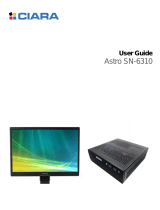
Solid-state drive, M.2 ........................................................................................................................ 30
WLAN module .................................................................................................................................... 32
Memory module ................................................................................................................................ 34
RTC battery ........................................................................................................................................ 35
USB board .......................................................................................................................................... 36
Speakers ............................................................................................................................................ 37
Power button board .......................................................................................................................... 39
Heat sink assembly ........................................................................................................................... 41
Fan ..................................................................................................................................................... 43
System board .................................................................................................................................... 44
TouchPad button board ..................................................................................................................... 47
Display assembly ............................................................................................................................... 48
Power connector cable ...................................................................................................................... 55
6 Computer Setup (BIOS) and MultiBoot ........................................................................................................... 57
Using Computer Setup ......................................................................................................................................... 57
Starting Computer Setup .................................................................................................................. 57
Navigating and selecting in Computer Setup ................................................................................... 57
Restoring factory settings in Computer Setup ................................................................................. 58
Updating the BIOS ............................................................................................................................. 58
Determining the BIOS version ......................................................................................... 58
Downloading a BIOS update ........................................................................................... 59
Using MultiBoot ................................................................................................................................................... 59
About the boot device order ............................................................................................................. 59
Choosing MultiBoot preferences ....................................................................................................... 60
Setting a new boot order in Computer Setup ................................................................. 60
Dynamically choosing a boot device using the f9 prompt ............................................. 60
Setting a MultiBoot Express prompt .............................................................................. 61
Entering MultiBoot Express preferences ........................................................................ 61
Using HP Sure Start (select models only) ............................................................................................................ 61
7 Device management .................................................................................................................................... 63
8 Diagnostics and Troubleshooting .................................................................................................................. 65
LEDs ..................................................................................................................................................................... 65
Wake-on LAN ....................................................................................................................................................... 65
Power-On Sequence ............................................................................................................................................ 66
Power-On Diagnostic Tests .................................................................................................................................. 66
Troubleshooting ................................................................................................................................................... 66
Basic Troubleshooting ....................................................................................................................... 66
vi




















